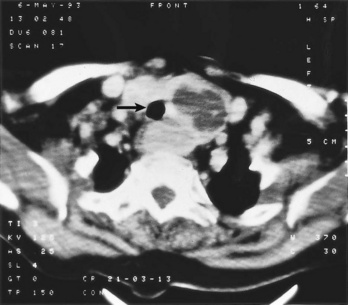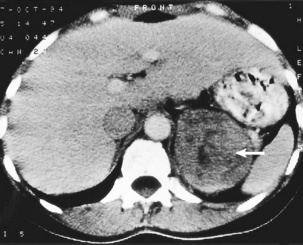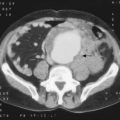CHAPTER 11 Endocrine surgery
Thyroid
Congenital
Symptoms of thyroid disease
Lump in the neck
• Smooth non-toxic enlargement of the gland. This is characteristic of a physiological goitre, which may occur at puberty or in pregnancy
• A smooth firm enlargement of the gland (occasionally asymmetrical), usually in middle-aged females and often associated with hypothyroidism, e.g. Hashimoto’s disease
• A solitary nodule in a lobe of the thyroid gland. This may be due to a palpable dominant nodule in a multinodular goitre, a cyst, an adenoma or a carcinoma
Hoarse voice
This is due to pressure on and/or malignant infiltration of one or both recurrent laryngeal nerves.
Investigation of thyroid dysfunction/swellings
Goitre
A goitre is an enlargement of the thyroid gland (for Classification → Table 11.1).
| Simple (non-toxic goitre) | Simple hyperplastic goitre Multinodular goitre |
| Toxic goitre | Diffuse (Graves’ disease) Toxic nodule (adenoma) Toxic multinodular goitre |
| Neoplastic goitre | Benign:
Malignant: |
Riedel’s thyroiditis
Neoplastic goitre
Malignant
Lymphoma (5%)
Treatment
• Well-differentiated (papillary/follicular) Total thyroidectomy and excision of all involved nodes. 123I diagnostic scanning for secondary disease and 131I ablation treatment. Life-long thyroxine treatment is required as (1) replacement therapy and (2) to achieve TSH suppression. Thyroglobulin estimations should be carried out 6-monthly as a marker of recurrent disease. Subsequent 131I therapy may be used for secondary disease – although bony secondaries are best treated with external beam irradiation.
• Anaplastic Surgery is rarely indicated. Response to radiotherapy is poor. Chemotherapy is usually ineffective. Surgical debulking to relieve pressure on the trachea and oesophagus may allow palliation.
• Medullary Total thyroidectomy with removal of all affected lymph nodes. Follow-up includes regular calcitonin levels. Detectable calcitonin levels suggest residual or recurrent tumour which should be sought and removed surgically. Recurrence of high calcitonin levels suggests tumour recurrence. These should be sought and removed surgically. Inoperable tumours should be irradiated.
Prognosis
• Differentiated (papillary/follicular). Prognosis can be excellent. Around 9% of patients will die of the disease and 30% will need treatment for nodal/secondary disease. Adverse prognostic factors include increasing age (especially over 40) at first presentation, male gender, extrathyroidal and metastatic spread.
Inflammatory conditions of the thyroid
Thyroidectomy
Operations
Principles of thyroidectomy
• Skin crease incision about two fingers breadth above the sternal notch. The incision should reach the sternocleidomastoid on each side
• Raised skin flaps (including subcutaneous fat and platysma) to the thyroid notch superiorly and the sternal notch inferiorly. Flaps may then be held by a self-retaining retractor (Joll’s retractor)
• Make a vertical incision through the deep fascia between the strap muscles and retract the strap muscle. If the goitre is large, the strap muscles are divided at their upper extremity because their nerve supply enters the lower part of the muscles
• Ligate the superior thyroid vessels close to the upper pole of the thyroid to avoid the external branch of the superior laryngeal nerve
• Draw the lobe of the thyroid gland medially and dissect the lateral connective tissue and identify the inferior thyroid artery
Parathyroids
Hyperparathyroidism
Three types occur: primary, secondary and tertiary.
Primary hyperparathyroidism
Adrenal gland
Adrenal cortex
Cushing’s syndrome
Investigations
• Overnight low dose dexamethasone suppression test – failure to suppress cortisol levels below 50 nmol/L suggests Cushing’s





